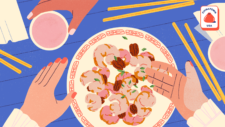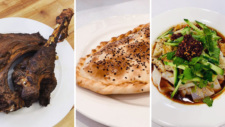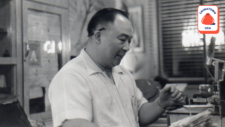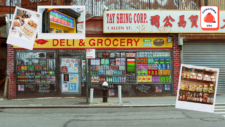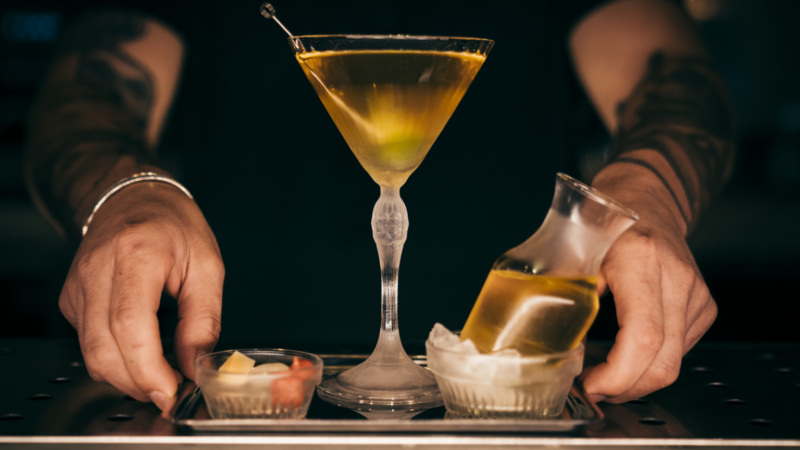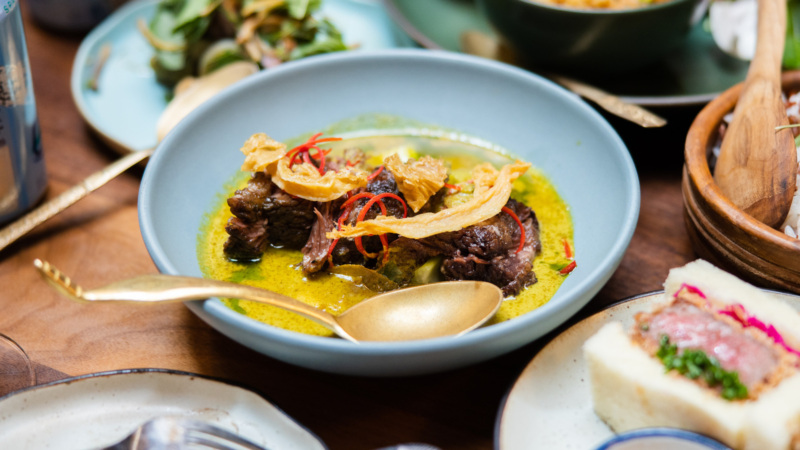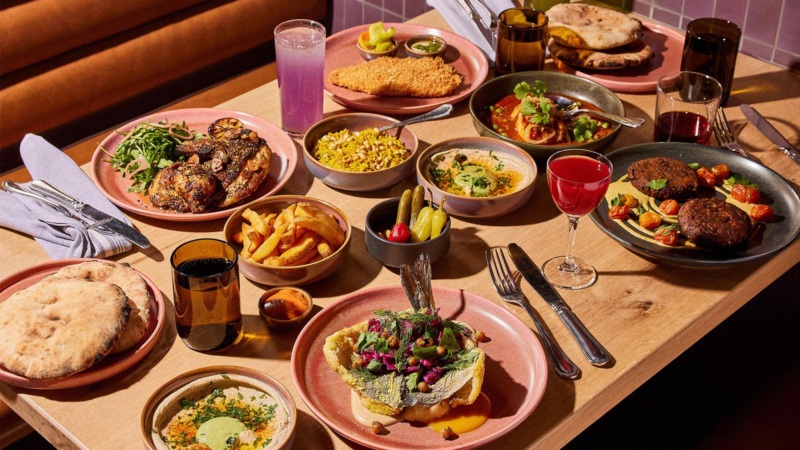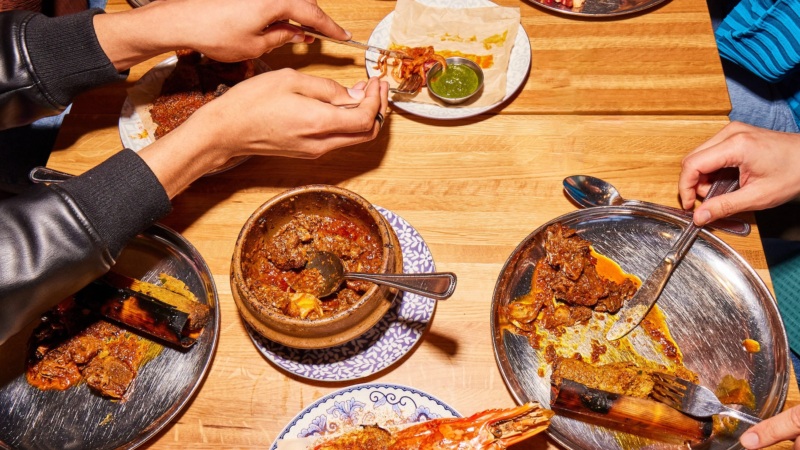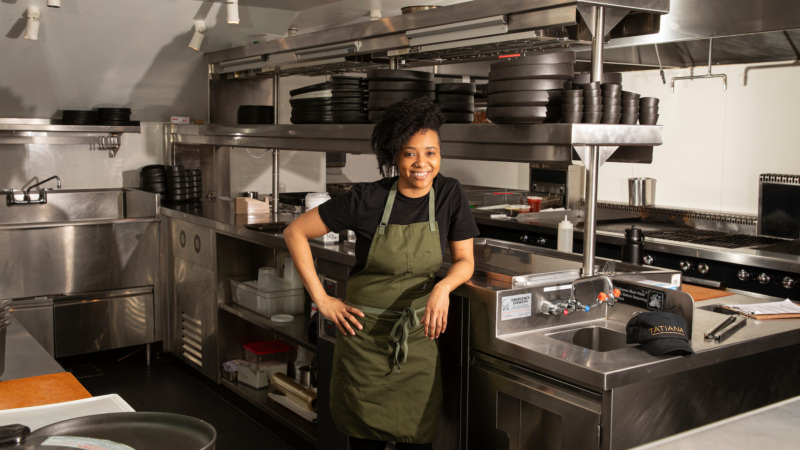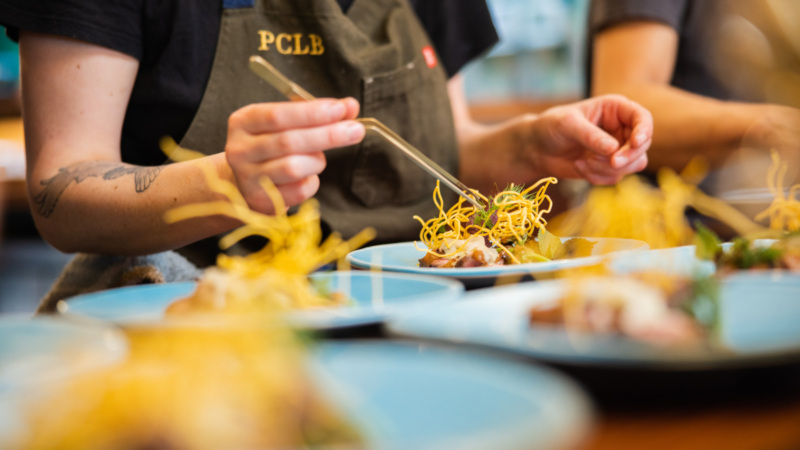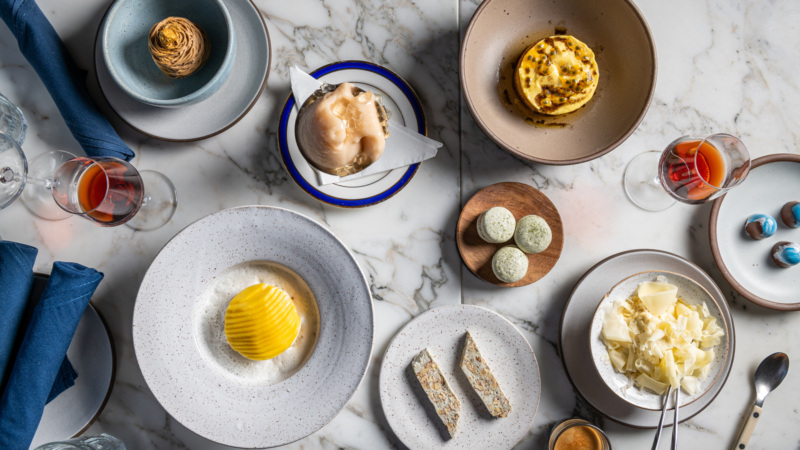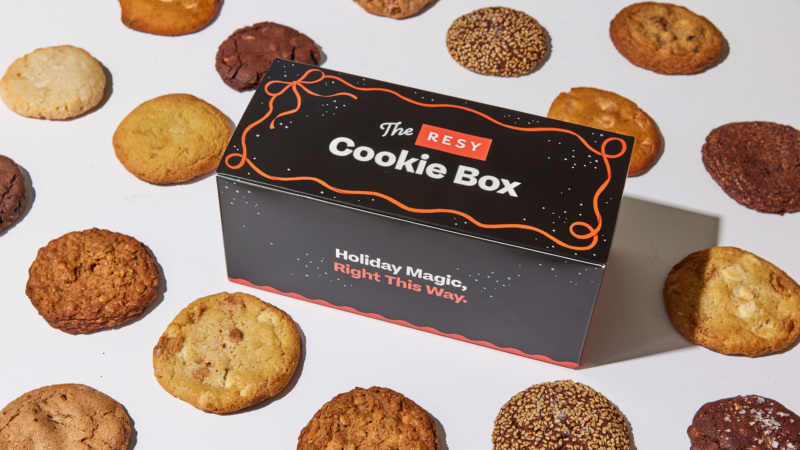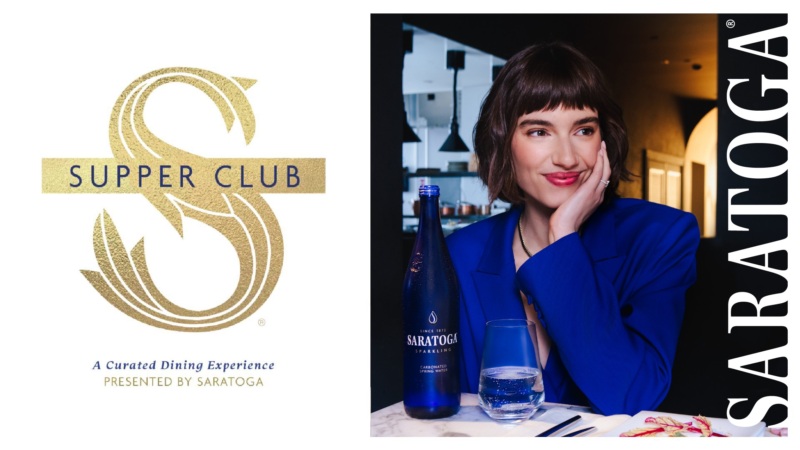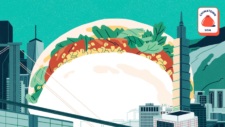

Chinese American Food Is Its Own Great Cuisine. Time to Love It That Way.
At least once a week, my dad would bring home takeout for the family. Sometimes, it was carnitas burritos, chile relleno, and menudo from Alfredo’s. Other times, it might be Double Doubles and animal-style fries (always extra crispy) from In-N-Out, or kalua pork and lau lau from L&L. Most times, though, it was our grandmother’s absolute favorite: Chinese American food.
No one was as ecstatic as Popo was when my dad brought home a Styrofoam container piled with fried fish filets. She’d lovingly pour the maraschino-cherry-hued sweet-and-sour sauce over the filets, and smile, closing her eyes after every bite. No order from Seafood Port was complete without that dish.
Then there was Panda Express. Oh, how she treasured every single morsel of the succulent orange chicken.
To me, this seemed entirely normal: Why wouldn’t my grandmother, a woman born and raised in Toisan, China, who moved to Wichita, Kansas, at 41, and then to L.A. at 60, love this kind of food? Until gradually, I realized maybe it wasn’t.
Over time, I began to realize that even though my own family adored Chinese American food, and thought of it as ours, my fellow Chinese Americans didn’t always see it that way.
I understand why. To many of us, whether you’re second (like myself) or fourth generation, there’s a marked difference between what we grew up eating at home and what you’ll find inside the steam tables at Panda Express, or at the local Chinese takeout. There’s no such thing as General Tso’s chicken or egg foo young in our Popo and Nai Nai’s kitchens.
Yes, I grew up eating plenty of sweet-and-sour-fish and orange chicken at home. But I also ate regional Chinese dishes my family made, food that represented my mom’s Toisanese roots and my dad’s Shanghainese side: restorative bowls of winter melon soup; the most perfectly sous-vide-but-not-really-sous-vide poached chicken with rice; the flakiest of scallion pancakes; filling sticky rice dumplings with pork belly, lapcheong, and peanuts.
There was “fusion” cooking, too, as when Popo made deep-fried sesame balls stuffed with peanut butter, instead of the traditional bean paste. Or when my mom made burritos, filling flour tortillas with napa cabbage and chicken laced with oyster sauce, and frying them in a sizzling hot pan like a chimichanga. I like to think that they were doing exactly what millions of other immigrants to America before them did: taking what was available and incorporating other cultures and influences from their new home into what they put on the family table. It’s a rite of passage for immigrant families everywhere.
Still, I know my family’s eating habits aren’t the same as other families, or even the generation that precedes me. That’s something my aunt Linda pointed out to me recently when I interviewed her for a story about her father — my grandfather — who owned Chinese American restaurants in Kansas in the 1950s. “We would never eat that kind of food at home,” she said of his restaurant’s best-sellers like chop suey, egg rolls, or chicken chow mein with crispy noodles.
***
To many Chinese Americans, what we define as Chinese American cuisine is, in the words of Ali Wong, “Frankenstein” food: an unholy mashup of all things sticky, sweet, deep-fried, and doused in MSG, jammed into a takeout container. It casts a long shadow over other Chinese cuisines — allegedly tricking non-Chinese people into believing all Chinese food is this way. It’s a foreign cuisine, one we distance ourselves from, one we’d never claim proudly as our own. It’s food for non-Chinese people, not for us.
I think about one of my closest friends, who worked at a Chinese restaurant in the suburbs of St. Paul, Minn., throughout college. For him, Chinese American food was considered a “treat.” At the restaurant, he loved sneaking in a few post-shift bites of “cream cheese wontons,” aka crab Rangoon, as his Chinese Vietnamese parents rarely ate the stuff.
Other friends’ parents would never think to bring orange chicken or sweet-and-sour fish into their homes. Even if they did, and even if a lot of my Chinese American friends weren’t opposed to eating such food, there was always an underlying opinion that it didn’t represent us. That it was inferior to real Chinese food — the food our parents and grandparents made for us at home. We second- or third-generation Americans might rush to the newest hotspot from a buzzy chef “reinventing” Chinese American classics, buoyed by James Beard nods, but we turn up our noses at the local Lucky Dragon, Peking Kitchen, or China Express.
Indeed, what many of us were told is that these places were symbols of selling out. To some, Chinese American food is and always has been a culinary kowtow to American, or at least Western, culture. It was engineered to appeal to American (read: non-Chinese) palates, dumbed down to be blander, thicker, sweeter. It’s food that doesn’t frighten people with duck tongues, tendon and tripe, or with mouth-numbing spices. It’s not what you’d find served at an elaborate Chinese banquet.
None of this is true: Chinese American food isn’t blander, thicker, or necessarily sweeter than any other Chinese regional cuisine. Moreover, it’s not scary, certainly not scarier than any other cuisine — should we talk about French charcuterie, or even bologna? And you might just find some similarities between Chinese American food and formal Chinese banquet food. (Hello, honey walnut shrimp.)
In fact, I’d argue that Chinese American food is just as authentic, and worthy of reverence, as any other regional Chinese cuisine. It started out as an immigrant cuisine more than 170 years ago, when people took their taste memories from home and tried to recreate them with limited ingredients. They adapted them to their new home. They bridged cultural divides by creating something that reflected their new dual lives.
It evolved then, and it continues to evolve. It represents our resolve, our ingenuity, our culture. And it’s about time it got some respect.
***
Few things illustrate the power of Chinese American food better than Popo’s beloved orange chicken: created in America, using American ingredients with flavors rooted in both America and China, for a restaurant company founded by two Chinese immigrants.
In an oft-repeated creation tale, orange chicken first debuted in Hawaii in 1987, when chef Andy Kao created it for the opening of a new Panda Express location. Kao took the sweet-and-sour flavor profile from Panda Express co-founder Andrew Cherng’s hometown in Yangzhou and combined it with citrus as a nod to the 50th state. Cherng got his start into the Chinese restaurant business in 1973, when he and his father, chef Ming-Tsai Cherng, opened Panda Inn in Pasadena, Calif., in 1973. Ten years later, following Panda Inn’s success, Andrew and his wife, Peggy, opened the first Panda Express in the Glendale Galleria mall.
Originally, in Hawaii, the dish used bone-in meat — a traditional cut for fried chicken in Asian restaurants — but Kao replaced it with bite-size pieces of boneless dark meat. The sauce he created, a recipe of brown sugar, vinegar, soy sauce, ginger, and crushed chile, is now replicated in thousands of Chinese restaurants around the world. It is Panda Express’ No. 1 dish, served in every single one of its more than 2,300 restaurants worldwide. In 2019, the chain sold more than 104 million pounds of orange chicken. On average, more than 285,000 people eat it every day. They, like my Popo, love it.
This matters because so many Americans get their first-ever introductions to Chinese food at Panda Express — or P.F. Chang’s, or their local Chinese restaurant. That was similarly the case for chef Jimmy Wang, director of culinary innovation at Panda Restaurant Group, Panda Express’ parent company.
“I moved [to America] from Taiwan when I was 14 years old,” he tells me. “My first taste of American Chinese food was actually at a Panda Express in Las Vegas. I remember eating orange chicken and kung pao, and loving it for the fact that it was so different from what I grew up eating.”
This is the strongest argument, in a way, for orange chicken — and General Tso’s, and yaka mein — as gateways. For one, they are delicious. Truly. Chinese American food is a study in building and balancing flavors: salty, sour, and sweet. And if one of the hallmarks of the great Chinese regional cuisines is texture, Chinese American food has mastered that as well. How else do you explain the sorcery in maintaining the crispness of orange chicken, even after it’s been lacquered in its thick sauce? The variety of ingredients you can incorporate into a chop suey is incredible — a great way to meet your daily vegetable intake, for sure. There’s intention in every bite. And all that MSG, despite whatever racist myths have persisted about it? A naturally occurring substance that captures umami in a bottle.
So frankly, it’s silly — even offensive — to consider Chinese American dishes as somehow lesser.
“Chinese American cuisine is a real cuisine, like Tex-Mex or Italian American red sauce,” says Carolyn Phillips, the author of “All Under Heaven,” a cookbook that explores China’s many regional cuisines. “The dishes are like baby steps toward these cuisines — a way for us to enjoy them and to begin to understand a different culture.”
***
Of course, the longtime worry has always been that Americans assume all Chinese food is like Chinese American food. Which is also silly. Of course, you’re not going to step off the plane in Beijing and find General Tso’s. (Actually, you will. But that’s another story, about globalization.) But with regional Chinese restaurants now in any city of size in the United States, we’re at least a generation past worrying whether people think Sichuan and Cantonese food are the same. For that matter, trying to define what constitutes Chinese food would take forever, since it embraces at least eight “great traditions” and countless lesser-known ones.
It’s equally silly to view Chinese American food as a monolith. America contains multitudes. And the food that we’ve adapted along the way is anything but uniform, whether it’s the earliest Chinese immigrants making chop suey, to my own grandfather, who cooked fried chicken and sweet-and-sour pork in Kansas, to the improvisation from today’s immigrants. All of these examples have proven to be more than successful; they’ve become cultural linchpins.
“If you think about it, chop suey is the greatest hustle, or greatest adaptation of food ever, because it managed to win over an entire continent,” says Clarence Kwan, aka The God of Cookery on Instagram. Kwan, a Chinese Canadian, started his Instagram account in 2017 to show how Chinese food, especially Cantonese food, can be a form of political resistance. (As you might guess, the same improvisation also takes place north of the border.)
On weekends, Kwan works as an apprentice at a Chinese barbecue restaurant in a suburb of Toronto where he cooks both traditional Chinese food and Chinese American favorites like lemon chicken and deep-fried chicken wings. He loves how the latter food makes customers happy.
“Who cares if it’s authentic to us, if we are happy to make a living off of it?” he asks.
This might be a mantra for how Chinese American food has endured. The earliest Chinese immigrants faced immense discrimination. The only jobs they could hold were in laundries and restaurants. It took guts for our ancestors to open restaurants at a time when they were considered “yellow peril,” when they were being lynched and chased out of cities, and when people accused them of eating rats. They made the best of what they were dealt, and they created one of the most popular cuisines in the world.
Chinese American food (and, yes, its north-of-the-border equivalent) “was a way our ancestors created something literally out of nothing,” Kwan says. At my grandfather’s restaurant in Wichita, for example, he grew mung bean sprouts for the chop suey out of repurposed garbage cans; it was impossible to get fresh Chinese vegetables shipped to the middle of the country, especially in the winter. “Happy Family,” like chop suey, is an ingenious way to use up all the ingredients in your walk-in. And just think of the marketing brilliance involved in taking cream cheese and stuffing it inside a wonton wrapper, frying it, and then branding it “crab Rangoon.”
Today, then, we’re simply taking what our grandparents and great grandparents did, making it our own, and inviting others to do the same.
In New York, Silver Apricot’s Simone Tong has transformed scallion pancakes into scallion puffs. In her take on lasagna, Nightshade’s Mei Lin has replaced Bolognese with mapo tofu in Los Angeles. Mission Chinese Food’s Danny Bowien introduced America to the spice-numbing joy of Chongqing chicken wings and kung pao pastrami, first in San Francisco and then in New York. Junzi Kitchen’s Lucas Sin is creating a new business model for Chinese American restaurants with Junzi’s offshoot, Nice Day, also in New York.
New arrivals during COVID have only magnified this: Pecking House’s Eric P. Huang adapted his fine-dining skills, and borrowed the kitchen at his uncle’s Queens restaurant, to meld the best of Taiwanese fried chicken with Nashville hot chicken. Fat Choy’s Justin Lee and Jared Moeller are putting a vegan twist on Chinese food in New York’s Lower East Side — mushroom sloppy joes sandwiched between scallion pancakes. And of course, in San Francisco, Mister Jiu’s Brandon Jew is on a mission to instill “a sense of pride in Chinese food again.”
For all of them, chop suey doesn’t have to be a glob; it can be whatever you make it. Meat sauces are meat sauces, whether mapo or ragù. Cauliflower deserves the salt-and-pepper treatment, too. The philosophy remains the same: Use what you have, cook what you know.
At the same time, let us not forget the mom-and-pop Chinese restaurants found in literally every corner of the country. The ones that rely on business from non-Chinese customers to break even, that stay open late, and always satisfy. The ones serving General Tso’s, orange chicken, sweet-and-sour fish. The ones struggling now, especially, because of the twin pandemics of COVID and xenophobia.
The more we value Chinese American food as its own cuisine, the more easily we’ll understand the regional differences among all the other Chinese cuisines. One day, we’ll all be able to distinguish the differences between Fujianese ban mian and a Cantonese wonton mein as easily as Americans now rattle off different Italian pasta shapes. (Enough for a temporary loss of bucatini to become a mini-crisis in the grocery aisle.) It won’t be easy, but we’ll get there. Americans may take our own path to understanding — just look at salsa, or bagels, or baked ziti — but we always adapt.
Deanna Ting is a Resy staff writer. Follow her on Instagram and Twitter. Follow Resy, too.


